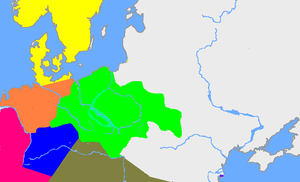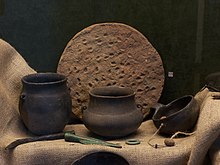Lusatian culture


The Lusatian culture existed in the later Bronze Age and early Iron Age (1300 BC-500 BC) in most of Poland, parts of Czech Republic and Slovakia, parts of eastern Germany, and parts of Ukraine. It covers the Periods Montelius III (early Lusatian culture) to V of the Northern-European chronological scheme.
The Lusatian culture developed as the preceding Trzciniec culture experienced influences from the middle Bronze Age Tumulus Bronze Age (Hügelgräberkultur), essentially incorporating the local communities into the socio-political network of Iron Age Europe (Dolukhanov 1996:113). It is contemporaneous with the Urnfield culture found from eastern France, southern Germany and Austria to Hungary and the Nordic Bronze Age in northwestern Germany and Scandinavia. It is followed by the early Iron Age Billendorf culture in the West. In Poland, the Lusatian culture is taken to span part of the Iron Age as well (the is only a terminological difference) and is succeeded in Montelius VIIbc in northern ranges around mouth of Vistula by the Pomeranian culture spreading south.
There were close contacts with the Nordic Bronze Age, and the Scandinavian influence on Pomerania and northern Poland during this period was so considerable that this region is sometimes included in the Nordic Bronze Age culture (Dąbrowski 1989:73). Hallstatt and La Tène influences are seen particularly in ornaments (fibulae, pins) and weapons.
Burial was by cremation, inhumations are rare. The urn is usually accompanied by numerous, up to 40 secondary vessels. Metal grave gifts are sparse, but there are numerous hoards (e.g. Kopaniewo, Pomerania) that contain rich metalwork, both bronze and gold (hoard of Eberswalde, Brandenburg). Graves containing moulds, like at Bataune, Saxony or tuyeres attest the production of bronze tools and weapons at village level. The 'royal' tomb of Seddin, Brandenburg, Germany, covered by a large earthen barrow contained Mediterranean imports like bronze-vessels and glass beads. Cemeteries can be quite large and contain thousands of graves.
Well known settlements include Biskupin in Poland and Buch near Berlin. There are both open villages and fortified settlements (Burgwall or grod) on hilltops or in swampy areas. The ramparts were constructed of wooden boxes filled with soil or stones.
The economy was mainly based on arable agriculture, as is attested by numerous storage pits. Wheat (emmer) and six-row barley formed the basic crops, together with millet, rye and oats, peas, broad beans, lentils and gold of pleasure (Camelina sativa). Flax was grown, and remains of domesticated apples, pears and plums have been found. Cattle and pigs were the most important domestic animals, followed by sheep, goats, horses and dogs. Pictures on Iron Age urns from Silesia attest horse riding, but horses were used to draw chariots as well. Hunting was practiced, as bones of red and roe deer, boar, bison, elk, hare, fox and wolf attest, but did not provide much of the meat consumed. The numerous frog-bones found at Biskupin may indicate that frog's legs were eaten as well.
Hoards in swampy areas are considered by some archaeologists (Hãnsel) as 'gifts for the Gods'. Human bones in 5m deep sacrificial pits in Lossow (Brandenburg) might point to human sacrifice and possible cannibalism.
History of research
'Lausitz-type' burials were first described by the German pathologist and archaeologist Rudolf Virchow (1821-1902). The name refers to the Lusatia (Lausitz) area in eastern Germany (Brandenburg and Saxony) and Poland. Virchow identified the pottery as 'pre-Germanic' but refused to speculate on the ethnic identity of their makers.
Numerous Czech (Píč, Niederle, Červinka) and Polish (Majewski, Kostrzewski, Kozłowski) authors believed the Lusatians to be Proto-Slavs, while the German archaeologist A. Götze saw them as Thracian, and Gustaf Kossinna first as Karpo-Dacian, a tribe mentioned by Zosimus and then as Illyrian.
Today, most scholars have accepted the historical and changing nature of ethnic groups and do not try to continue ethnic groups known from written sources into the prehistoric period.
Further reading
- J. M. Coles and A. F. Harding, The Bronze Age in Europe (London 1979).
- Dabrowski, J. (1989) Nordische Kreis und Kulturen Polnischer Gebiete. Die Bronzezeit im Ostseegebiet. Ein Rapport der Kgl. Schwedischen Akademie der Literatur-Geschichte und Altertumsforschung über das Julita-Symposium 1986. Ed Ambrosiani, B. Kungl. Vitterhets Historie och Antikvitets Akademien. Konferenser 22. Stockholm.
